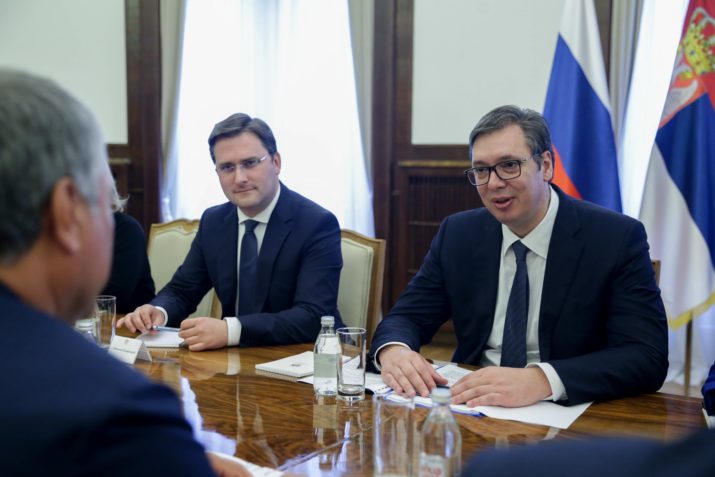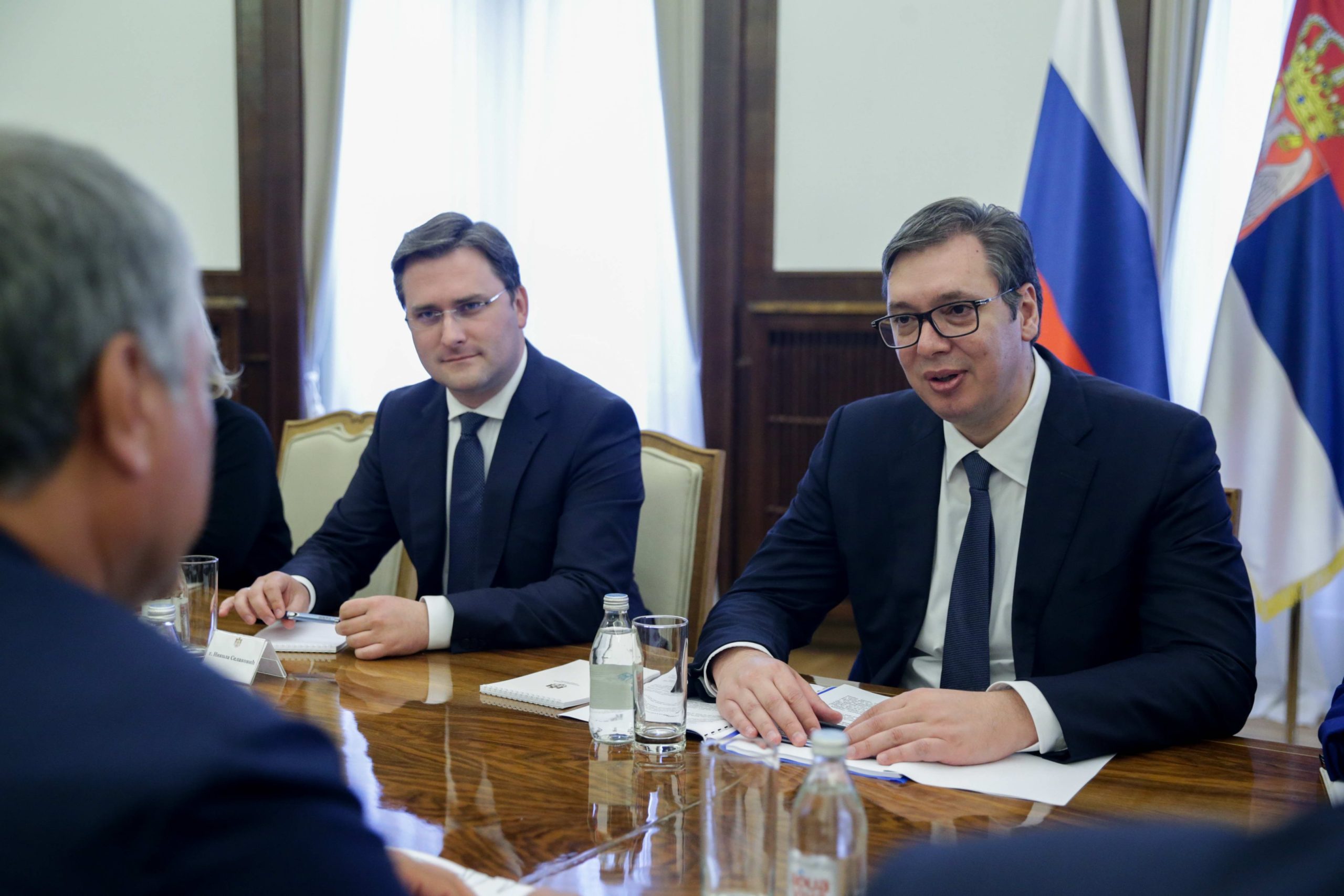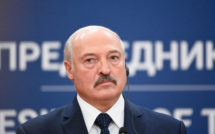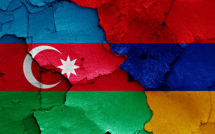

This is part of a roundtable on the EU Neighborhood.
The year 2020 could be considered a make-or-break period for EU-Serbia relations. While EU’s new enlargement methodology and the COVID-19 pandemic strengthened the complex institutional and economical bond between the two entities, the results of the June general elections and President Aleksandar Vučić’s internal crisis management methods raise serious questions regarding the EU’s approach towards democratic backsliding in Serbia. These developments come against a background of constant attempts by foreign actors (mainly Russia and China) to derail Serbia from its European path, using soft-power instruments (humanitarian and military aid, infrastructure investments etc.).
Serbia – the EU’s disobedient candidate?
In order to get a clear understanding of the political climate and the impact of recent developments on the country’s relationship with the EU, one must first delve deeper into Serbia’s democratic track record beyond 2020. The country received full candidate status for membership of the EU in 2012. While opening the majority of its negotiation chapters, Serbia has made modest efforts to tackle its deeply-rooted democratic shortcomings, as it is shown in the most recent report issued by the European Commission. Nevertheless, the country is still considered a “paradoxical frontrunner” of the accession process, as many issues are still to be tackled, despite its advancement in the accession negotiations. A measure which could prove to be decisive in the following years to come is the European Commission’s new enlargement methodology, which—if accepted by Belgrade and adjusted to its current needs—could speed up negotiation, while providing Serbian citizens with a clearer overview of the progress made and the logic of accession negotiations.
Among the most pressing problems currently faced by Serbia is the deeply polarized political landscape, a situation which leads to an inability to conduct fair elections, as the parliamentary majority (both before and after July 2020 elections) tends to exclude large parts of the citizens bringing up the question of both functionality of political pluralism and legitimacy of the ruling party/coalition. This particular situation can be rooted in the lack of transparent and inclusive political dialogue, an issue observed by OSCE’s recent documents,[1][2] but which remained largely unaddressed by local authorities. Corroborated with a serious lack of progress in judicial reform, limited progress in the fight against corruption and the formalistic de-politicization of public administration,[3] Serbia remains a country where the governing majority holds a tight grip of any situation that concerns the internal affairs.
With a constantly manifested disrespect for democratic (and EU) values, the brutal outcome of last summer’s protest doesn’t appear as surprising as the media portrayed it. Using state capture mechanisms, Serbia’s ruling political organization, the Serbian Progressive Party (SNS) led by Aleksandar Vučić, has extended its power over every aspect of society and politics. Loyalty (based on employment) of the law enforcement institutions was used to bring to an end the events of July 7-8, while the public was forced to accept less strict prevention measures but all with a cost.
COVID-19 and Serbia – where does the EU stand?
While the new enlargement methodology (triggered by France’s rejection to open negotiations with Albania and North Macedonia) was finalized, Europe faced a much more dangerous challenge—the COVID-19 pandemic swept the continent leaving many infected in need of urgent assistance and claiming thousands of lives. Serbia was by no means bypassed as ICU units throughout the country were registering rising numbers of infections and admissions.
Since the outbreak of the pandemic, the EU has supported Serbia, allocating €93 million since March, of which €15 million were for emergency care and €78 million for economic recovery. In light of these figures, the EU remains Serbia’s main donor, despite attempts made by China and Russia to use the pandemic as a soft-power tool. Both these countries pledged medical aid to Belgrade, in an attempt to exert their influence in the region. While Beijing used the pandemic as another tentacle of its Silk Road by sending aid as early as March (with an enthusiastic recognition by Vučić, who went on to call president Xi his “brother”), Russia only became a major player in November, when news of a potential vaccine purchase[4] by Belgrade came to surface.
The EU has a twenty-year history of assistance provided to the Serbian healthcare system, amounting to €200 million in donations and €250 million in loans, numerous (re)construction and modernization projects from which 2,5 million Serbs benefited. Thus, with more money already pledged in October 2020 as part of its economic and investment plan,[5] the EU is clearly the strongest and most pragmatic voice in Serbia, despite the country’s (geo)political and administrative inconsistencies.
The July 2020 protests – a turning point for EU-Serbia relations
On July 7, President Aleksandar Vučić announced that the government in Belgrade would reimpose mandatory distancing steps and a tough curfew amid a rising number of coronavirus cases. The announcement was made amid a growing number of recorded victims (thirteen people had died in only one day of reporting, the most since the start of the pandemic). The decision came just two weeks after Vučić’s Serbian Progressive Party (SNS) won the parliamentary elections with 62 percent of the votes, gaining 191 of the 250 seats in Parliament—a result quickly accepted by the European Union, despite numerous recordings of irregularities and limits brought to political competition, especially due to the opposition boycott.
Videos posted on social media showed police appearing to clash with protesters two nights in a row, using tear gas and batons to disperse the crowd. Local media also reported officers in plain clothing attempting to prevent the media from filming the scenes. Scores of police officers and protesters were injured and dozens of civilians were arrested the first night after thousands of people descended in downtown Belgrade, as some tried to force their way into the parliament building. The July 7-8 incidents included police violence against civilians, men and women, posing no apparent threat, as well as against journalists.[6] Clashes were also documented in other cities of Serbia—Novi Sad, Niš, Kragujevac and Smederevo, where police was also recorded to mishandle the situation.
By July 9, both President Aleksandar Vučić and Prime Minister Ana Brnabić had backed away from proposals for a nationwide or citywide curfew, announcing instead more limited measures to stop the accelerating spread of the virus in the capital. Vučić condemned what he described as the most brutal political violence for years and called for the end of the protests, citing the risk of increased infection. But the images of protesters (some of them students) being brutally beaten and teargassed by the police will surely remain in the collective memory for a long time.
Nevertheless, the question remains as to the reasons that sparked such a brutal outcome of what should have been a peaceful protest? In a report[7] published the day after the elections, the Balkan Investigative Reporting Network (BIRN) alleged that leaked data “from the state’s COVID-19 information system” showed the official infection and death figures for a two-month period before the voting were half of what they actually were. During this time, the Serbian authorities relaxed some of the strict measures imposed in March, at the outbreak of the pandemic, a move which could be considered an attempt to gain political leverage, by creating an impression of normalcy. Both Vučić and Brnabić were quick to dismiss the BIRN report as false, claiming the numbers “are not authentic,” while blaming opponents for “misinformation” and “playing politics.” But the public and the representatives of the healthcare system weren’t convinced by the two officials. Furthermore, after daily infections began to surge in June, there has also been a trickle of protests of doctors and other healthcare workers. On a more peaceful but still meaningful note, hospital workers turned their backs on Brnabić and the country’s health minister during a visit to Novi Pazar, one of the country’s COVID-19 hotspots, to protest hospital conditions and inaction by officials. Although not as striking as the images of injured passersby, the message transmitted by healthcare workers in a period of epidemiological crisis must be considered, as they are the first line responders.
The situation in July 2020 brought back images from numerous protest movements that have marked Serbia’s recent history: from the anti-Milošević movement in 2000, to the Belgrade Waterfront protests in 2014, or the recently-ended “Jedan od pet miliona” (“One of Five Million,” 2018-2020). Each of these large-scale protests are a clear signal that, despite its internal polarization, the Serbian society is to be taken seriously when it comes to breaches of law and threats to everyday life posed by ruling officials, no matter the cause. This is especially significant, as protest becomes a last resort option for a society affected by countless violations of freedoms. This signal so far has been greeted by Vučić and his ruling party with nothing more than promises of electoral value (swap elections—2014, 2016), without tangible measures taken in order to improve relations with the general public on a long term. These slim political reactions are themselves fueling public distrust and dissatisfaction towards political institutions, transforming Serbia in a clear case of captive state.
Serbia’s EU bid – a challenging negotiation ahead
Although news and images of the brutal crackdown of the protests in Belgrade made worldwide headlines, the European Union’s main institutions were not so swift in issuing an official statement. The reaction is not as surprising as it may seem, as despite the constant mixed-to-negative evaluations of the European Commission on election conditions and press freedom,[8] the result of the elections of June 21 were accepted. Moreover, the European Parliament parties reacted (somehow unsurprisingly) along partisan lines: the Socialists and Progressives (in line with local and international observers) called the Serbian elections a mockery of democracy. Meanwhile, Donald Tusk, of the European People’s Party, congratulated their party family associate, the SNS, only noting ominously, “more power, the more responsibility.”
Bearing in mind the EU’s own track record in dealing with authoritarian drifts in the region (the cases of Gruevski’s Macedonia or Edi Rama’s Albania quickly coming to mind), the EU simply cannot afford to have its credibility in the Western Balkans put under question once again, by supporting the results of a contested political group. Based on these mixed responses given by the European institutions, a renewed approach vis-à-vis enlargement negotiations should be considered by all concerned parties, especially as the EU benefits from a wide array of tools, as I will discuss below:
A. The European Parliament
Rather than reacting in line with political affinities, the EP’s main groups should consider transforming democracy and rule of law sine qua non conditions for engaging with sister parties in candidate states. Such a decision would prevent democracy from becoming a partisan issue in Serbia, putting pressure on local elites to refrain from developing and maintaining autocratic tools in relation with the electorate. Only by cutting the political and financial power cord of such local leaders, can Serbia become a pluralistic society, with respect for freedom of expression and equal chances for everyone to participate in the electoral process. With a lot on its plate following the May 2019 elections, and with enforced powers (given by the Lisbon Treaty) the European Parliament must step up and prove its role in the enlargement process, holding accountable politicians from candidate states, when official documents issued by its Rapporteurs observe shortfalls and misconducts.
B. The European Commission
As observed in the past five years, the EU has its struggles when it comes to dealing with illiberal / autocratic tendencies. But compared to Member States Poland or Hungary, the EU, in particular the Commission, can extend more pressure on candidate partners who mock democratic and/or European values. The recently approved negotiation methodology could become a quintessential tool, allowing the Commission to guide its approach based on the four principles enshrined in the February 2020 document. Moreover, Brussels may now use the “stronger focus on the core role of fundamental reforms” clause as a deal-breaker, slowing down or even suspending the accession talks altogether, as a clear signal given to Belgrade (and other candidates). Another tool, though risky in these uncertain circumstances would be cutting off the available funds. Although both instruments may be drastic and last resort options, not using them would also seriously affect EU’s credibility in the region, bringing along further delays to any enlargement prospects from which the region has benefited in the last twenty years.
C. EU Member States
Although not as consistent as the Commission, the Council of the EU and the European Council (where a de facto veto process may paralyze any decision at any time) are very much part of the accession process, having a say in the accession progress. As such, any downslide in Serbia’s track record on rule of law should be more serious touched upon in intergovernmental conferences. During these meetings, representatives of the Serbian government must be made aware of the consequences brought by their internal actions or lack thereof. The Council of the EU is a key part in this process, as this institution holds the final say in the negotiations on each chapter. Here, the institution has several tools to pick from—it can either refuse the opening of any new chapters, or even invoke the imbalance clause, an eight years old instrument, which allows negotiations to be frozen on all chapters if not enough progress is made on the rule of law. Again, a last resort option, but one which could signal a more coherent and pragmatic approach of Member States vis-à-vis the enlargement process. Nevertheless, as the new enlargement methodology (not yet accepted by Belgrade) strengthens Member States’ political leverage (as seen in the recent Bulgaria-North Macedonia dispute, or Romania’s 2012 veto threats towards Serbia—the latter without concrete actions taken by Bucharest), leaders of the European institutions must ensure that countries such as France or the Netherlands do not become permanent “bullies” of Serbia, by playing the “national interest card.” Such a move would affect even more the EU’s credibility and could bring the end of EU-Serbia accession talks, even without bringing about the omnipresent Kosovo topic.
D. Serbia
Perhaps the most difficult task belongs to the newly-appointed Serbian Government—amid a healthcare and economic crisis, Belgrade must learn how to pick its battles and partners, while continuing to accelerate on its European path. Despite the multitude of assistance options provided by China, Russia and the EU, Serbian authorities must acknowledge the consistency of the Brussels offer, while keeping in mind that all of EU’s money come at a cost. Respecting democratic values and improving its track record on rule of law and fight against corruption might in fact be a long-term win for president Aleksandar Vučić’s political party, despite its visible reluctance to comply to outside imposed rules. As elections results and history put it, Vučić’s continued tight grip on local institutions is expected to last for another mandate with freedoms and rights seriously questioned once again. Meanwhile, the EU’s patience with a disobedient candidate might reach a limit—in this scenario, the above-mentioned last resort options of the EU might not seem so far-fetched. In any case, the results of July elections and their violent outcome will surely delay any negotiation progress, as the new (old) governing party in Belgrade is known for its tough stance on EU conditionality, preferring the company of less exigent economic partners, who do not interfere with its way of handling domestic (and democracy-threatening) issues.
Could it be…?
The last six years of negotiations have been characterized by a backslide of democracy in Serbia, while the EU has remained fairly silent on the matter. Having this in mind, the protests of July 7-8 should have been approached by the EU as a signal that the newly-elected (old) leadership from Belgrade is pursuing a “business as usual” strategy vis-à-vis its own citizens, disregarding democratic values and freedoms and putting Serbia’s (European) future at risk.
This year, marked by a healthcare crisis (which generated an economic one) and a revision of the EU’s negotiation methodology, could have brought new prospects for Serbia’s EU bid. While Brussels’ post-election reaction has been disappointing, threatening the future of democracy in the Balkan country, its humanitarian efforts might be just the trigger needed to boost the wobbling relation. As Serbia remains a captured state, the EU must make use of its recently acquired tools and exert much-needed pressure on Belgrade to fulfill its commitments as candidate. But all this while handling the delicate balance between “carrots” and “sticks,” in a moment when every slip might feed the geopolitical aspirations of Moscow and Beijing in the Western Balkans with a direct impact on the global ambitions of EU.
Dragoș Ioniță is a PhD candidate and junior researcher in the Department of International Relations and European Studies of National University of Political Science and Public Administration (SNSPA). His main field of interest is the process of Europeanization of the Western Balkans as part of the EU enlargement process of the countries in the region. As member of the Department’s Centre of European Studies, he was actively involved in co-organizing several events and conferences on the EU enlargement process in the Western Balkans and is currently part of several research academic networks that aim to bring EU policies closer to the general public, of which most notable are OpenEUDebate and Linking to Europe at the Periphery.
References:
[1] OSCE. 2020. “Support to the inclusive and transparent development of Media Strategy,” pp. 4-7, accessed November 20, 2020, available at https://www.osce.org/files/f/documents/f/0/461605.pdf.
[2] OSCE. 2020. ODIHR Special Election Assessment Mission – Republic of Serbia Parliamentary Elections (21 June 2020), p. 13, accessed November 20, 2020, available at: https://www.osce.org/files/f/documents/a/3/466026.pdf.
[3] European Commission. 2020. Communication on EU Enlargement Policy – Serbia Report, p. 8-18, accessed November 20, 2020, available at: https://ec.europa.eu/neighbourhood-enlargement/sites/near/files/serbia_report_2020.pdf.
[4] TASS. 2020. “Serbia in talks on COVID-19 vaccine with China and Russia,” accessed November 20, 2020, available at: https://tass.com/world/1227827.
[5] European Commission. 2020. “Western Balkans: An Economic and Investment Plan to support the economic recovery and convergence,” accessed November 20, 2020, available at https://ec.europa.eu/commission/presscorner/detail/en/IP_20_1811.
[6] Balkan Insight. 2020. “Serbian Police Attack Journalists In Second Night of Clashes,” accessed November 20, 2020, available at: https://balkaninsight.com/2020/07/09/serbian-police-attack-journalists-in-second-night-of-clashes/.
[7] Balkan Insight. 2020. “Serbia Under-Reported COVID-19 Deaths and Infections, Data Shows,” accessed November 20, 2020, available at: https://balkaninsight.com/2020/06/22/serbia-under-reported-covid-19-deaths-and-infections-data-shows/.
[8] European Commission. 2019. Communication on EU Enlargement Policy – Serbia Report, p. 5-20, accessed November 20, 2020, available at: https://ec.europa.eu/neighbourhood-enlargement/sites/near/files/20190529-serbia-report.pdf.
Photo: Meeting of Chairman of the Russian State Duma Vyacheslav Volodin and Serbian President Aleksandar Vučić
Published on February 9, 2021




